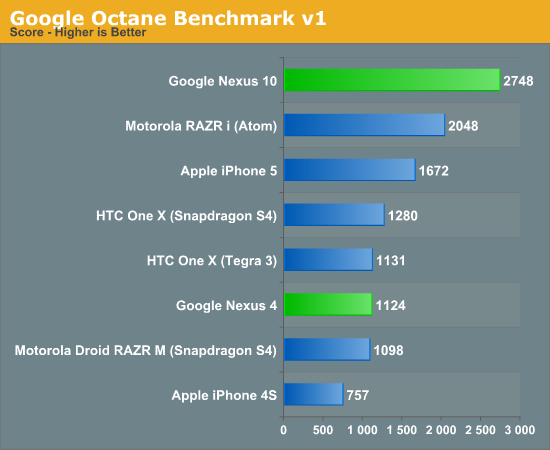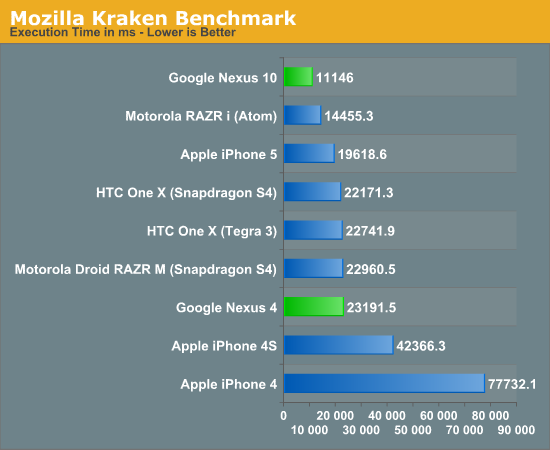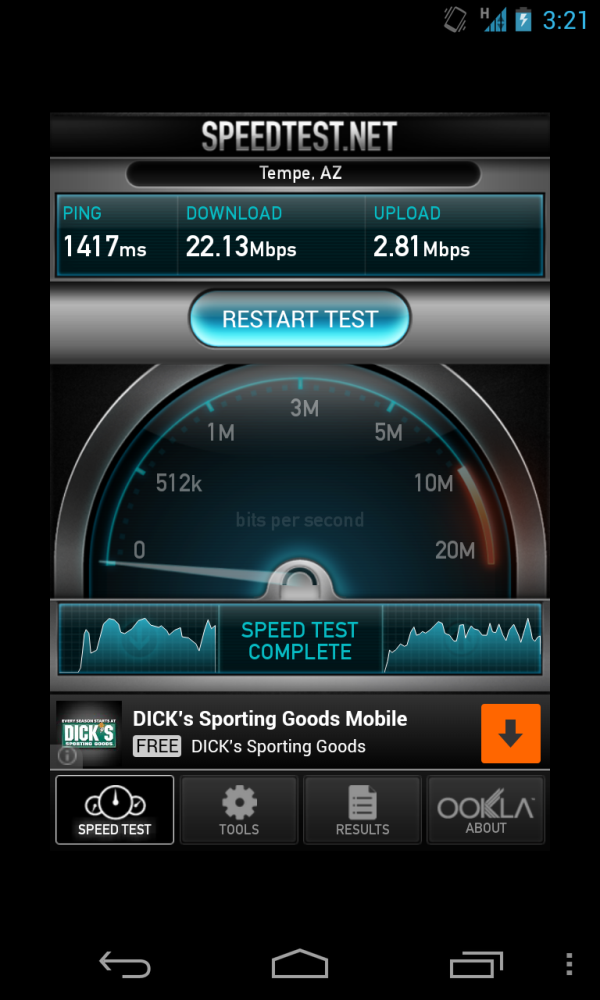Google Nexus 4 and Nexus 10 Performance Preview
by Anand Lal Shimpi & Brian Klug on November 2, 2012 11:00 AM ESTEarlier this week Google announced two new flagship Nexus devices: the Nexus 4 smartphone and the Nexus 10 tablet. We received review samples of both earlier this week, and while we're hard at work at full reviews of the devices we couldn't help but share all of the test data we've been able to amass at this point.
For those who aren't familiar with it, the Nexus 4 features Qualcomm's Snapdragon S4 Pro SoC - a quad-core 28nm Krait CPU with Qualcomm's next-generation Adreno 320 GPU. The combination proved quite formidable in the MDP/T we tested, as well as LG's recently announced Optimus G. The SoC drives a 4.7-inch 1280 x 768 IPS display and is paired with 2GB of LPDDR2 memory. The Nexus 4 ships unlocked with 8GB of NAND for $299 without a contract ($349 for the 16GB version). Pair that with DC-HSPA+ support and you get an absolute killer smartphone for use on T-Mobile: no contracts, very low monthly fees, and compelling cellular performance:
Brian will talk more about the combination in his full review, but rest assured that the lack of LTE is workable depending on T-Mobile coverage where you live/travel to.
The Nexus 10 also boasts a brand new SoC: Samsung's Exynos 5 Dual. The Exynos 5 Dual features two ARM Cortex A15 cores running at 1.7GHz as well as ARM's own Mali-T604 GPU. This happens to be the exact same platform used in the new Chromebook, just running Android. The Nexus 10 features a 10.1-inch 2560 x 1600 display, giving it the same resolution as the 13-inch MacBook Pro with Retina Display - but in an even smaller form factor. Google is also aggressive on Nexus 10 pricing: the 16GB WiFi-only tablet sells for $399, with the 32GB version going for $499.
Both Nexus devices run Android 4.2 and are guaranteed to be the first devices to be updated to upcoming Android revisions for the foreseeable future (it's the power of Nexus).
We haven't had a ton of time to test the devices and put this together so you're going to see combined performance charts throughout the rest of this article.
CPU Performance
The big story when it comes to CPU performance is a look at how the Cortex A15s perform under Android. Unfortunately we're still left with mostly browser based benchmarks to measure CPU performance, which actually highlights a major issue in our testing: Android V8 optimization doesn't seem to be anywhere near as good as it is under Chrome OS or Windows. As a result, all of the Nexus 10 performance scores end up slower than the new Chromebook - despite using the same SoC and running Chrome on both platforms. It's also possible that the Exynos 5 Dual in the Chromebook is allowed to burn a bit more power, translating to better performance, but either way the solution here in the Nexus 10 doesn't look as good across the board.

SunSpider performance is good, but not significantly better than Qualcomm's Krait based Snapdragon S4. Both the iPhone 5 and RAZR i are able to outperform the Nexus 10. The S4 Pro based Nexus 4 tends to be in line with other S4 based devices - SunSpider doesn't really give much credit to the extra 2 cores.

BrowserMark puts the Nexus 10 behind many platforms that should be faster, I'm even wondering here if there's some hard partitioning of memory bandwidth between the CPU and GPU to drive the 2560 x 1600 display that's simply choking the CPU here.
The Nexus 4 does ok, but again there seem to be some V8 optimization issues at work here under Android 4.2. At 1.5GHz it should deliver at least the performance of the dual-core Snapdragon S4 solutions.

Octane is the first test where the Cortex A15s are really able to flex their muscle - the Exynos 5 Dual based Nexus 10 manages to outperform the RAZR i by 34%, and compared to the A6/Swift based iPhone 5 the advantage grows to 64%.
The Nexus 4 performs about in line with other Snapdragon S4 based devices, although once again the extra 2 cores don't seem to be doing much for it here at all.

Kraken also paints the Cortex A15 based Nexus 10 in a good light: there's a 30% advantage over the RAZR i and a 76% advantage over the iPhone 5. These numbers will shrink a bit compared to other tablets, but not by much. The Nexus 4, once again, ends up performing similarly to dual-core Snapdragon S4 based devices.
Overall, the Nexus 10 results show us some real promise for what we can expect from ARM Cortex A15 based SoCs. The potential upside to this new architecture is huge.

















244 Comments
View All Comments
johnyertanton - Friday, November 2, 2012 - link
Are you sure you read the graph correctly. Nexus 10 has the 3rd worst constrast ration. Looks like Nexus 4 was the best, maybe you confused the two?the_engineer - Sunday, November 4, 2012 - link
Thanks, your right I did misread that. Either way it's difficult to make any decision without the other tablets' numbers to compare to. Thanks for that though.flyflytn - Friday, November 2, 2012 - link
Your head just spins sometimes from all these charts. Its easy enough to analyse a few of them, but to comprehend and juggle what they all mean together in comparing devices to each other is a major feat. I agree with some other posters here - what does it *feel* like to use. Who cares if some device is 5 times faster than another if you don't actually get to see this benefitI don't play games on my portables, but I do appreciate some grunt in them still for doing other things.
Which brings me to something I'd like to suggest / see at AT
I have never seen a good site review that talks about how good some of the other parts in these things are - things like compass, GPS & accelerometer tests. It might sound less interesting to most, but its becoming more and more important with location based apps.
eg. I use my phones for personal tracking (sports / geocaching / mapping / whatever), yet the GPS devices in some high end phones are anything but highend. They're woeful at waiting for a lock and woeful at keeping a lock, poor accuracy etc.
Also their compasses are often poor with reproducibility & accuracy too.
How about some subjective testing in this area ? Doesn't need to be overwhelming, just a 10 sample test for locking, 10 sample test for accuracy / keeping lock etc.
Compare it to a high end GPS device for example, something will real accuracy ?
I personally would find these tests more useful than how fast something can fill fragment lit triangles.....
Krysto - Friday, November 2, 2012 - link
Anand, these browser benchmarks are becoming way too dependent on the browser. Can you at least add some Quadrant and other benchmarks in the mix, to see how they perform? And don't just show the final score like every other site does, show the scores for everything (CPU, GPU, memory, I/O, etc), and explain what they mean and how they compare with the others.gevorg - Friday, November 2, 2012 - link
The benchmarks are nearly useless unless they show the OS version and the browser version. Unlike on the iOS side, there are too many variables on the Android side that need to be clearly stated.AnotherHariSeldon - Friday, November 2, 2012 - link
Anand can only test with the benchmarks that are available.I'm not sure why anyone is surprised by the outcome. The iPhone5 and iPad 4 SoC's are using the best CPU/GPU combination so get the best scores.
Krysto - Friday, November 2, 2012 - link
Here's what Exynos 5 Dual got in Sunspider on the Chromebook:http://www.anandtech.com/show/6422/samsung-chromeb...
It's the SAME chip. And yet Google's Chrome for Android, which is 4 versions behind the desktop Chrome, and probably has an even older V8 engine than that, manages to make this excellent chip that is normally faster than everything, perform twice more poorly.
At the end of the day, it's Google's screw-up for shipping both Nexus 10 and Nexus 4 in such a horrible shape in terms of the browser they are using, but I'm just noting this is not about the raw performance of the CPU here, but about the poor software Google put in here, as if they didn't even care what they slapped on top of the hardware.
The GPU does seem more powerful than Mali T604, but it also seems to sacrifice battery efficiency for extra performance, while Mali T604 does not. The iPad uses a significantly larger battery and significantly lower resolution, and yet it only beats the Nexus 10 by half an hour on battery life, which is less than 10%.
Filiprino - Friday, November 2, 2012 - link
The Mali T604 is the basic model of the T600 series. And yes, the Chromebook has much better scores.Aenean144 - Saturday, November 3, 2012 - link
Heh, have you seen the WP8 IE Javascript scores? Wow. Pretty impressed. And Samsung puts some special sauce in their browser too.Like with everything, put benchmarks in their proper context.
doobydoo - Saturday, November 3, 2012 - link
'It's the SAME chip'No it isn't.
The Nexus 4 even performs differently to the Optimus G.
There are more factors than just the chipset. Even the clock speeds are different when compared to the Chrome book. Then you have potentially different throttling etc.
You can't say that just because such and such performance is found in a LAPTOP that it'll be the same in the phone. The Benchmarks show the true story as we know it thus far.